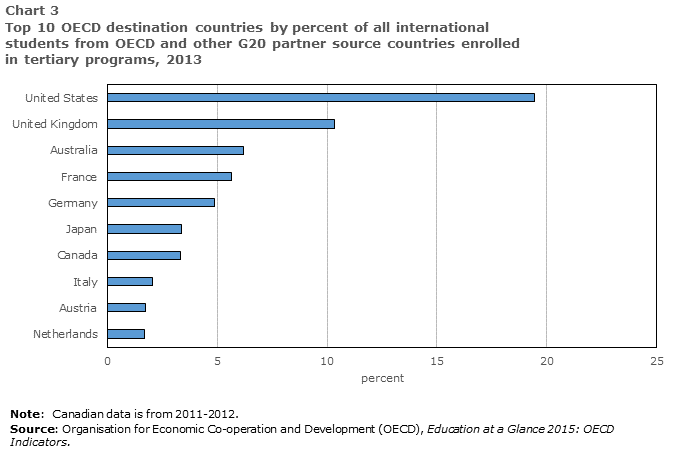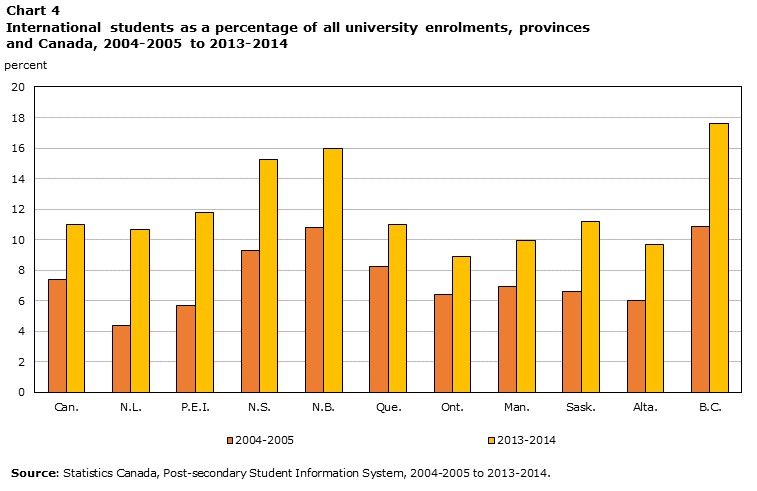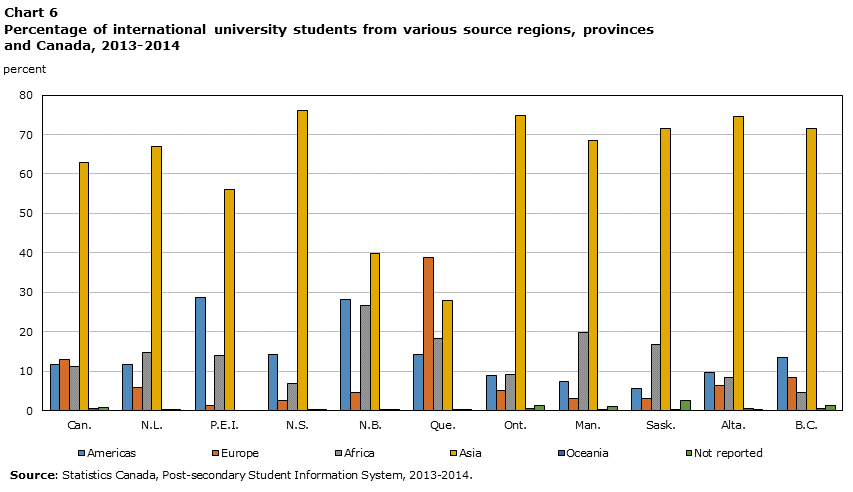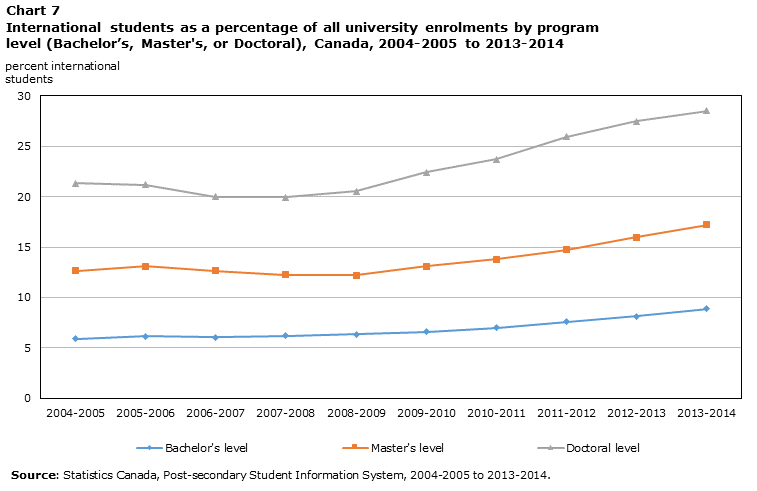International students in Canadian Universities, 2004-2005 to 2013-2014Note 1
Archived Content
Information identified as archived is provided for reference, research or recordkeeping purposes. It is not subject to the Government of Canada Web Standards and has not been altered or updated since it was archived. Please "contact us" to request a format other than those available.
Introduction
Countries compete in order to attract international students for a number of reasons. From a broader social perspective, “international students strengthen Canada’s schools, universities, and colleges, as well as the Canadian communities in which they study and live, and they contribute to the quality of the educational experiences of all students in Canada.”Note 2 Provincial education ministries of higher education also seek out international students for the diversity that international students bring to postsecondary campuses. For example, the British Columbia International Education Strategy notes that this diversity “helps make B.C. more globally minded and builds better international connections”Note 3.
From an economic perspective, the arrival of international students on Canadian campuses can represent a flow of highly skilled talent that can help ease domestic skills shortages not filled by the native-born populationNote 4. A recent study notes that of the cohort of international students who came to Canada to study during the 1990s and early 2000s, 20% to 27% obtained permanent resident status in the 10 years after receiving their first study permitNote 5. Thus, a substantial proportion of these students come to study, but eventually choose to make Canada their home. Finally, international students provide an additional source of revenue for postsecondary institutions, notably from higher international tuition rates.
The most recent available data show that international students comprise a growing proportion of the Canadian university student population accounting for eleven percent of students at Canadian universities in 2013-2014, up from seven percent in 2004-2005. Between 2004-2005 and 2013-2014, the total number of international students enrolled in Canadian universities almost doubled, from 66,000 to 124,000 students (see Chart 1). To put this growth in perspective, the international student population at Canadian universities grew 88% between 2004-2005 and 2013-2014, while the comparable growth rate for Canadian students was 22%.
This fact sheet provides a portrait of international students in Canadian universities between 2004-2005 and 2013-2014, where they were studying in Canada, where they came from and in what fields they were studying.

Data table for Chart 1
| Year | Percentage of International Students | Number of international students |
|---|---|---|
| 2004-2005 | 7.4 | 65,934 |
| 2005-2006 | 7.7 | 69,864 |
| 2006-2007 | 7.5 | 69,816 |
| 2007-2008 | 7.7 | 71,841 |
| 2008-2009 | 7.8 | 74,685 |
| 2009-2010 | 8.2 | 84,351 |
| 2010-2011 | 8.7 | 92,016 |
| 2011-2012 | 9.4 | 102,615 |
| 2012-2013 | 10.1 | 112,767 |
| 2013-2014 | 11.0 | 123,840 |
| Source: Statistics Canada, Post-secondary Student Information System (PSIS), 2004-2005 to 2013-2014. | ||
Start of text box
Definitions:
International students are defined as those who left their country of origin and moved to Canada for the purpose of study. In Canada, the concept of “international students” includes non-permanent residents, such as those with a study permit. It also includes those enrolled in a Canadian program from a Canadian institution that is not located in Canada (also known as “offshore students”) as well as non-Canadian students studying via the Internet.
The population studied in this report includes students enrolled in Canadian universities in Bachelor’s, Master’s or Doctoral programs or their equivalents (ISCED levels 6, 7, and 8). While other kinds of programs are also delivered at universities, they are not part of this analysis.
End of text box
Canada in comparison with other Organisation for Economic Cooperation and Development (OECD) countries
Relative to other countries, in the 2012-2013Note 6 school year Canada ranked slightly higher than the OECD average for international students as a proportion of all students for all three levels of study (see Chart 2). In relation to other primarily English speaking countries, Canada has hosted a lower proportion of international students than Australia, the United Kingdom, and New Zealand, but a higher one than Ireland and the United States.
In all of the countries shown in Chart 2, international students made up a progressively increasing percentage of all enrolments from Bachelor’s to Master’s to Doctoral levels, except for Australia, where the percentage of international Master’s students exceeded that for Doctoral students.

Data table for Chart 2
| Country | Bachelor's level | Master's level | Doctoral level |
|---|---|---|---|
| percent | |||
| Australia | 14 | 38 | 33 |
| United Kingdom | 13 | 36 | 41 |
| New Zealand | 13 | 20 | 43 |
| Canada | 8 | 16 | 27 |
| OECD average | 6 | 14 | 24 |
| Ireland | 6 | 10 | 25 |
| United States | 3 | 8 | 32 |
|
Note: In order to show the same reference year (2012-2013), values for Canada come directly from the Postsecondary Student Information System. Source: Organisation for Economic Co-operation and Development (OECD), Education at a Glance 2015: OECD Indicators and Statistics Canada, Postsecondary Student Information System, 2012-2013. |
|||
Another way to compare Canada to other OECD countries in terms of hosting international students is to look at Canada’s share of all international students from OECD and partner G20 source countries (see Chart 3). By this measure, Canada received a share that tied with Japan for sixth place (3.4%). The top three places went to other primarily English speaking countries, with the United States being first (19.4%), United Kingdom second (10.3%), and Australia third (6.2%). France ranked fourth, receiving 5.7% of all international students.

Data table for Chart 3
| Destination country | Total from all countries, 2013 |
|---|---|
| percent | |
| Netherlands | 1.7 |
| Austria | 1.8 |
| Italy | 2.0 |
| Canada | 3.4 |
| Japan | 3.4 |
| Germany | 4.9 |
| France | 5.7 |
| Australia | 6.2 |
| United Kingdom | 10.3 |
| United States | 19.4 |
|
Note: Canadian data is from 2011-2012. Source: Organisation for Economic Co-operation and Development (OECD), Education at a Glance 2015: OECD Indicators. |
|
International students by province
The proportion of international students on university campuses has increased in all provinces over the past decade (see Chart 4). The largest change in proportions between 2004-2005 and 2013-2014 took place in British Columbia (+6.7), the Atlantic provinces (Newfoundland and Labrador, Prince Edward Island, Nova Scotia, and New Brunswick) with increases of between 5.2 to 6.3 percentage points and Saskatchewan (+4.6).
In 2013-2014, Ontario, Alberta, and Manitoba had the lowest proportions of international students, at 8.9%, 9.7%, and 10.0% respectively. By contrast, British Columbia, New Brunswick and Nova Scotia had the highest proportions of international students, with 17.6%, 16.0% and 15.3% respectively.

Data table for Chart 4
| Province of Study | International Students | |
|---|---|---|
| 2004-2005 | 2013-2014 | |
| percent | ||
| Can. | 7.4 | 11.0 |
| N.L. | 4.4 | 10.7 |
| P.E.I. | 5.7 | 11.8 |
| N.S. | 9.3 | 15.3 |
| N.B. | 10.8 | 16.0 |
| Que. | 8.2 | 11.0 |
| Ont. | 6.4 | 8.9 |
| Man. | 7.0 | 10.0 |
| Sask. | 6.6 | 11.2 |
| Alta. | 6.0 | 9.7 |
| B.C. | 10.9 | 17.6 |
| Source: Statistics Canada, Post-secondary Student Information System, 2004-2005 to 2013-2014. | ||
Source regions for international students
Asia was the main source region for all international students in the OECD in 2012-2013Note 7 (53%). This was also the case in Canada in 2013-2014, with Asia’s share growing to almost 63% of university international students in 2013, up from 55% in 2004 (see Chart 5). Between 2004-2005 and 2013-2014, while the proportions of international students from Europe, Africa, Oceania, and other regions did not change much, those from the Americas showed a decrease of 7.6 percentage points.

Data table for Chart 5
| Region of origin | 2004-2005 | 2013-2014 |
|---|---|---|
| percent | ||
| Asia | 55.2 | 62.9 |
| Americas | 19.4 | 11.8 |
| Europe | 11.9 | 12.9 |
| Africa | 10.8 | 11.1 |
| Not reported | 2.3 | 0.9 |
| Oceania | 0.5 | 0.4 |
| Source: Statistics Canada, Post-secondary Student Information System, 2004-2005 to 2013-2014. | ||
In 2013-2014, Asia was the largest source region of international students for most provinces (40% to 76% of all international students; See Chart 6). The exception was in Quebec where Europe was the largest source region at 39% (the main source country being France).
With respect to individual source countries for Canada in 2013-2014, the top five were China (34.1%), France (7.6%), the United States (6.2%), India (5.7%), and Saudi Arabia (4.5%). China was the main source country for all provinces in 2013-2014, except for Quebec (France at 34.0%), and New Brunswick (Trinidad and Tobago, at 20.4%)Note 8.

Data table for Chart 6
| Province of Study | Americas | Europe | Africa | Asia | Oceania | Not reported |
|---|---|---|---|---|---|---|
| percent | ||||||
| Can. | 12 | 13 | 11 | 63 | 0 | 1 |
| N.L. | 12 | 6 | 15 | 67 | 0 | 0 |
| P.E.I. | 29 | 1 | 14 | 56 | 0 | 0 |
| N.S. | 14 | 3 | 7 | 76 | 0 | 0 |
| N.B. | 28 | 5 | 27 | 40 | 0 | 0 |
| Que. | 14 | 39 | 18 | 28 | 0 | 0 |
| Ont. | 9 | 5 | 9 | 75 | 0 | 1 |
| Man. | 7 | 3 | 20 | 68 | 0 | 1 |
| Sask. | 6 | 3 | 17 | 72 | 0 | 3 |
| Alta. | 10 | 6 | 8 | 75 | 0 | 0 |
| B.C. | 13 | 9 | 5 | 71 | 1 | 1 |
| Source: Statistics Canada, Post-secondary Student Information System, 2013-2014. | ||||||
International students by level of program
Since 2004-2005, graduate programs have had a higher percentage of international students, with doctoral level programs (Postsecondary 3rd cycle) having a higher percentage than master’s level programs (Postsecondary 2nd cycle). While the increase in the proportion of international students at the undergraduate level was steady between 2004-2005 and 2013-2014, the proportion at the doctoral and master’s levels have showed a small decrease followed by a return to an increase during that same time period. (see Chart 7).

Data table for Chart 7
| Year | Bachelor's level | Master's level | Doctoral level |
|---|---|---|---|
| percent international students | |||
| 2004-2005 | 5.9 | 12.6 | 21.3 |
| 2005-2006 | 6.1 | 13.1 | 21.2 |
| 2006-2007 | 6.0 | 12.6 | 20.0 |
| 2007-2008 | 6.2 | 12.3 | 19.9 |
| 2008-2009 | 6.4 | 12.2 | 20.5 |
| 2009-2010 | 6.6 | 13.1 | 22.4 |
| 2010-2011 | 7.0 | 13.8 | 23.7 |
| 2011-2012 | 7.6 | 14.7 | 25.9 |
| 2012-2013 | 8.2 | 16.0 | 27.5 |
| 2013-2014 | 8.9 | 17.2 | 28.5 |
| Source: Statistics Canada, Post-secondary Student Information System, 2004-2005 to 2013-2014. | |||
At each program level, the top 10 source countries in 2013-2014 represented a large portion of international students, almost three quarters at Bachelor’s and Master’s levels and close to two thirds at the Doctoral level (see Table 1). Several countries are in the top ten for all levels (China, France, United States, Saudi Arabia and India), and they contribute a large share of the international students at these levels. However, some other countries are only associated with one or two levels, and do not account for as large a number of students. For example, Iran is not in the top 10 source countries for the Bachelor’s level, but is sixth (4.7%) at the Master’s level, and second (15.1%) at the Doctoral level.
| Rank | Bachelor's level | Master's level | Doctoral level | |||
|---|---|---|---|---|---|---|
| Country | % | Country | % | Country | % | |
| 1 | China | 40.0 | China | 25.5 | China | 16.4 |
| 2 | France | 6.9 | India | 13.1 | Iran | 15.1 |
| 3 | United States | 5.6 | France | 9.5 | United States | 9.4 |
| 4 | Saudi Arabia | 4.3 | United States | 5.9 | France | 8.1 |
| 5 | Nigeria | 3.6 | Saudi Arabia | 5.8 | India | 5.4 |
| 6 | India | 3.4 | Iran | 4.7 | Saudi Arabia | 2.9 |
| 7 | Republic of Korea | 3.4 | Bangladesh | 2.4 | Egypt | 2.2 |
| 8 | Pakistan | 1.9 | Pakistan | 2.3 | Germany | 2.1 |
| 9 | Hong Kong | 1.7 | Nigeria | 2.0 | Mexico | 1.9 |
| 10 | Malaysia | 1.2 | Tunisia | 1.4 | Bangladesh | 1.6 |
| Source: Statistics Canada, Post-secondary Student Information System, 2013-2014. | ||||||
International students’ fields of study
International students were fairly concentrated in their top two fields of study with almost half of these students taking Business, Management and Public Administration (27%) and Architecture, Engineering and Related Technologies (19%). Notably, this concentration was not as marked for Canadian students - 17% of Canadian students were in Business, Management and Public Administration and 9% were in Architecture, Engineering and Related Technologies. The other fields of study in the top five for international students were Social and Behavioural Sciences, and Law (15%), Physical and Life Sciences, and Technologies (10%) and Humanities (8%).
Between 2004-2005 and 2013-2014, the top five subjects have remained the most popular, with Business, Management and Public Administration at the top, and Architecture, Engineering and Related Technologies increasing the most (from 15% to 19%).
The most popular program for international students at the Bachelor’s level was Business, Management and Public Administration (33%), while for both Master’s and Doctoral levels it was Architecture, Engineering and Related Technologies (27% and 30%, respectively – mostly in engineering).

Data table for Chart 8
| Field of study | 2004-2005 | 2005-2006 | 2006-2007 | 2007-2008 | 2008-2009 | 2009-2010 | 2010-2011 | 2011-2012 | 2012-2013 | 2013-2014 |
|---|---|---|---|---|---|---|---|---|---|---|
| percent | ||||||||||
| Business, Management and Public Administration | 24.9 | 25.5 | 26.0 | 25.4 | 25.7 | 27.1 | 26.8 | 27.0 | 26.8 | 27.2 |
| Architecture, Engineering and Related Technologies | 14.6 | 14.5 | 14.8 | 15.4 | 16.4 | 16.9 | 17.5 | 18.1 | 18.4 | 18.9 |
| Social and Behavioural Sciences, and Law | 15.3 | 15.4 | 15.4 | 15.2 | 15.0 | 14.6 | 14.6 | 14.6 | 14.9 | 14.9 |
| Physical and Life Sciences, and Technologies | 10.2 | 10.3 | 10.3 | 10.3 | 10.6 | 10.4 | 10.4 | 10.3 | 10.4 | 10.3 |
| Humanities | 11.3 | 11.4 | 12.2 | 12.0 | 10.7 | 10.2 | 10.1 | 9.7 | 9.0 | 8.4 |
| Source: Statistics Canada, Post-secondary Student Information System, 2004-2005 to 2013-2014 | ||||||||||
Start of text box
Canadian residents studying abroad:
As of 2012-2013, there were about 47,690 Canadian university students studying abroad. According to the Organization for Economic Cooperation and Development (OECD), the top destination countries for Canadian university students studying abroad (see Chart 10) included the United States (54.9%), the United Kingdom (12.9%), Australia (7.6%), and France (2.8%).

Data table for Chart 9
| Host country | Total |
|---|---|
| percent | |
| New Zealand | 0.8 |
| Switzerland | 0.9 |
| Poland | 1.0 |
| Korea | 1.1 |
| Germany | 1.3 |
| Ireland | 2.0 |
| France | 2.8 |
| Australia | 7.6 |
| United Kingdom | 12.9 |
| United States | 54.9 |
| Source: Organisation for Economic Co-operation and Development (OECD), Education at a Glance 2015: OECD Indicators. | |
End of text box
Conclusion
Canadian institutions and different levels of government within Canada strategize in order to attract international students and compete with other countries in this respect. In recent years, these strategies have brought some success with the proportion of international students on Canadian university campuses increasing from 7% of all students in 2004-2005 to 11% in 2013-2014. However, it should be noted that world-wide, the number of international students is rising in general, with the OECD stating that this is because of an “increase in global demand for tertiary education, reduced transportation and communication costs, and the internationalisation of labour markets for highly skilled people”Note 9.
In terms of success relative to other predominantly English-speaking countries, Canada’s proportion of international students is lower than most of these countries, with the exception of the United States and Ireland. It is difficult to compare countries’ situations however, as the contexts are quite different. For example, in the United Kingdom, which has a substantially higher proportion of international students than Canada at the tertiary level, there are fewer barriers for students from other countries in Europe to study in the United Kingdom and a close geographical proximity to the rest of Europe. In contrast, the United States has a relatively low proportion of international students at the tertiary level, but hosts the largest number of international students. Australia with a similar population size and situation in terms of geographic isolation, has a much higher proportion of international students at the undergraduate level – 14% to Canada’s 8%. Australia also receives a larger share of international students from the OECD and other OECD G20 countries – 6% versus 3% in Canada.
In Canada, the presence of international students is felt most strongly at the doctoral level, accounting for 29% of these students in Canada. This compares to 9% at the bachelor’s level and 17% at the master’s level. Nevertheless, due to the sheer size of the bachelor’s programs, most of Canada’s international students study at the bachelor’s level. Perhaps one of the most notable characteristics of international students in Canada is that almost half of international students were concentrated in business and engineering - two career-focused fields of study. This concentration was more marked for international students than for their Canadian counterparts.
Comparative issues aside, international students are a growing presence on Canadian university campuses, a reflection of their importance to these institutions and to Canadian society.
Notes
- Date modified:
